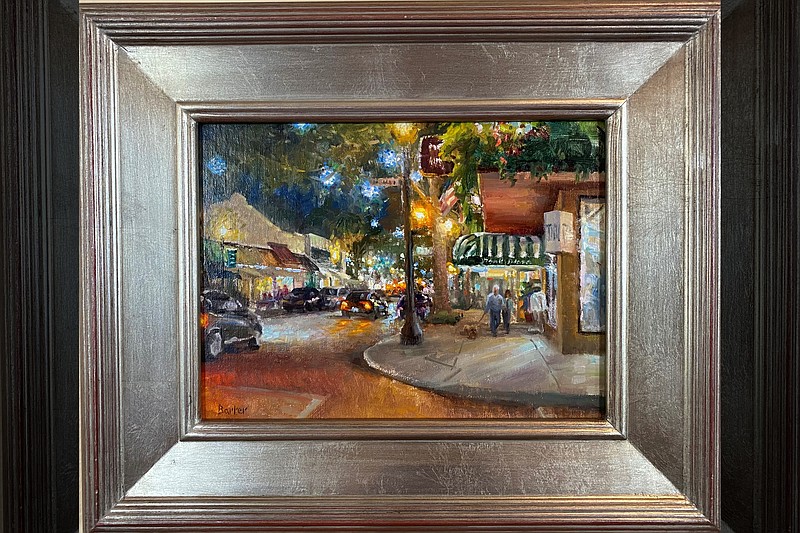My husband and I agree on many aspects of home decor, but artwork isn't one of them. He likes modern abstracts. I like traditional oils. So rather than try to find a piece we both agree on, which would pretty much leave us with bare walls, we take turns.
The last piece we bought was from an artist he chose, so the next piece was mine. I knew just who the artist would be.
A classically trained painter who has taught painting all over the world, Stacy Barter also happens to be a neighbor. Every December, I attend the open studio sale she hosts at her home. I also try to stop by her booth at local art shows. Every time, I say "someday."
So last month, around the time my husband was fortuitously asking what I wanted for Christmas, Barter sent around an email saying that because of the coronavirus, she would not be hosting her annual holiday open studio sale, but would still offer 20% off any painting. My heart thumped.
I jumped on her website and froze. Again. Because I can never decide on just one. I resonate with so much of her art: she paints the California coast, where I grew up. She paints the historic town of Winter Park, Fla., where she and I live.

I finally narrow my subject matter to the town I share with this artist, which seems fitting. I ask via email whether she has any paintings of our town in my (smallish) budget. She sends pictures of a few candidates. None was The One.
None was the one because I actually knew what I wanted. I just didn't know I knew. I kept looking for a painting of hers I first saw a few years ago, a painting of a couple walking their dog down a charming street in our town at night. It had this magical, floating, enchanted feeling. That painting had sold, and was also out of my price range, but the memory lingered.
"Since I have waited sooo long to finally get one of your pieces," I wrote back, "I'm looking for a painting that hits my sweet spot and budget. Are you planning anything along the lines of 'Late Stroll along Park Ave,' but smaller, so could fit my price range?"
"Let's chat through a few ideas I have tomorrow," she responded. "I look forward to figuring out what you will love."
What? Is this possible? It is! She can paint another angle of the same street, but smaller, 9-by-12. And poof! Just like that I fell into the world of commissioned art, a luxury I always presumed was for art lovers who never have to ask how much.

The next day Barter sends me several photos of Park Avenue at night. One captures the restaurant where my husband and I had our first date seven years ago. That's it.
Next, she texts a photo of the painting in progress. She'd roughed in a couple walking their dog. "Would it be too corny if the couple resembles us and our dog?" I ask. She loves the idea.
Soon, a finished, personalized painting, better than I could have imagined, and exactly what I wanted found its way into our home for Christmas.
"I never thought to ask," I said to Barter. "I just kept waiting for that perfect piece to materialize."
Here's what to consider when working with an artist to get just what you want:
◼️ Find an artist whose work you like. Make sure that you don't just like the artist but also his or her style. That you won't change.
◼️ What to relay. Tell the artist what of his or her paintings most speak to you and why. Also discuss price and size. "You want a client who can express what they are excited to see in the painting," Barter said. "You communicated what you were excited about, which made the process easier. The toughest clients are those who can't tell you the look and feel they want."
◼️ Don't over direct. Because I wanted to make sure her eye not mine was guiding this piece, when I made a suggestion, I would add, "Don't do anything you don't love." m Start with a picture. A lot of commissions start with a client photo, or one the artist takes. That eliminates a lot of guess work.
◼️ Stay involved. Because, unlike buying art in a gallery, you can't see the final product of a commissioned piece until it's done, check in along the way. Barter texted me pictures of the work underway, for input. For instance, at one point, I said, I wanted the couple to be smaller and more to the side. Done. That step builds confidence on both sides, Barter said.
◼️ Not for every artist. For an artist, the upside of a commissioned piece is that it's a guaranteed sale. However, not every artist will work this way. "Some don't want the interaction, and just want to paint what they want," she said. Other artists only do commissioned work, most often portraits.
◼️ Ask. Sometimes in life you get exactly what you want. But only if you ask.
Syndicated columnist Marni Jameson is the author of five home and lifestyle books, including "Downsizing the Blended Home — When Two Households Become One".
